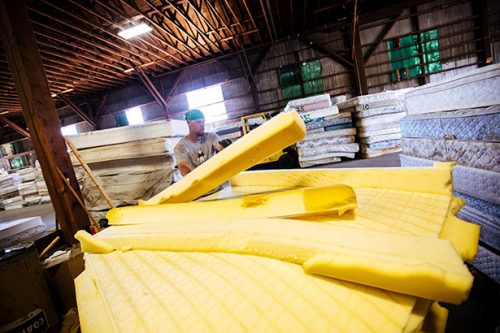
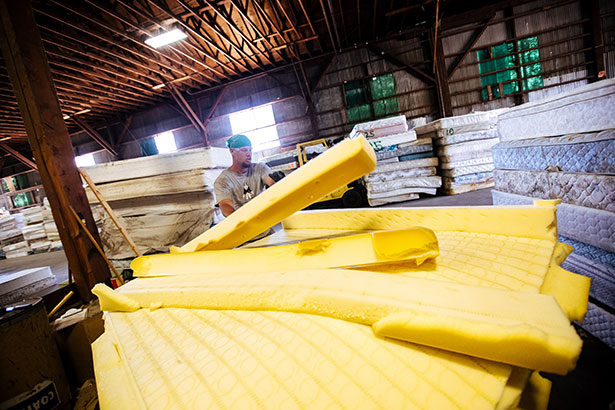 |
| Mark Blossom deconstructs a mattress in one of St. Vincent de paul’s mattress recycling facilities. Photo by Todd Cooper. |
Let’s produce ideas instead of timber.
That’s something FertiLab Thinkubator mentor Shane Johnson says could help transition Eugene and Springfield from resource-based communities to hubs of business and idea production.
“There are a lot of people with ideas here,” Johnson says. “Culturally, getting the momentum to grow beyond Lane County is difficult. We’re an understated town, so even though there’s success here, it’s not visible and there aren’t a lot of models.”
Johnson envisions a Eugene where people can start a business and thrive, where ideas flourish and have potential to gain traction outside the county.
We’re not entirely there yet, but local business incubators and accelerators are nourishing and encouraging ideas in all stages of development, growing from within and spreading outward. Eugene has its fair share of success stories — think running shoes and a swoosh — but now it’s time to look forward.
Johnson says Eugene and Springfield need more diversity, greater hustle, interested investors and more visible success stories for ideas to truly grow. “Midsized cities that don’t transfer to a culture of entrepreneurship will stagnate. We need a visible big win,” he says.
So check out these five success stories from Eugene and the University of Oregon — all featured ideas started small, then garnered attention on a national or international scale — and remind yourself that Eugene does have a lot to be proud of.
The Innovator
There’s a scene from “The Princess and the Pea” unfolding in west Eugene. Stacks of mattresses in all colors and shades take up ample floor space, forming a sizeable pile. But the magic castle these mattresses are stored in is St. Vincent de Paul of Lane County’s mattress recycling facility. The facility processes at least 35,000 mattresses per year.
It turns out there’s money in old mattresses — metal, wood and foam can all be salvaged — and St. Vincent de Paul of Lane County, an affiliate of the National Council of the U.S. Society of St. Vincent de Paul, is using that money to help people. Now, other nonprofits around the country want to learn how St. Vinnie’s does it.
Sue Palmer, a former reporter for The Register-Guard, manages the Cascade Alliance, a program created by St. Vincent de Paul of Lane County to help other nonprofits pick up St. Vinnie’s knack for taking would-be trash out of the waste stream, a process that includes harvesting old mattresses, selling used books online and setting up successful thrift stores. Palmer says Lane County’s St. Vinnie’s created its business model out of necessity in the 1980s, when timber jobs disappeared.
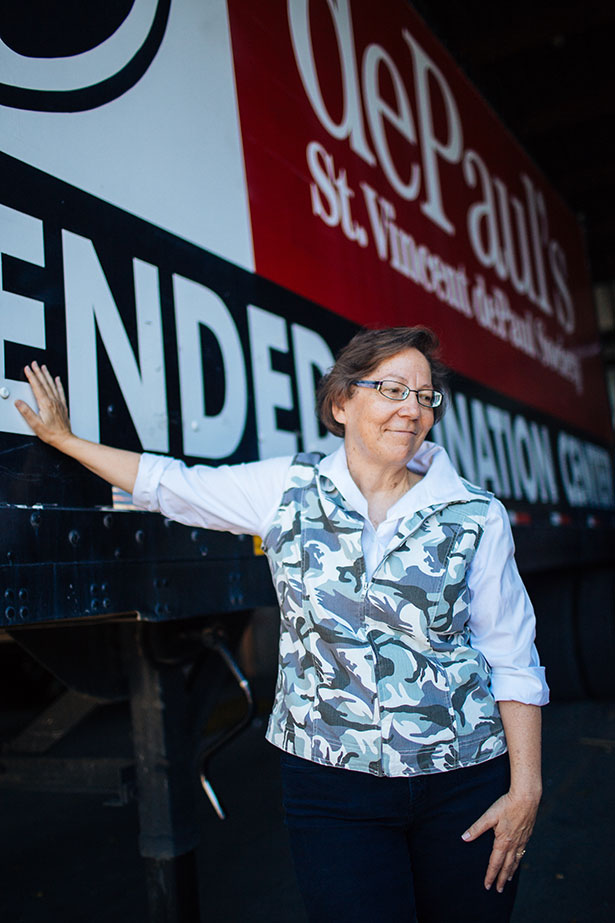 |
| Sue Palmer. Photo by Todd Cooper. |
“Terry McDonald, who’s been the executive director of St. Vincent de Paul [of Lane County] for many years, saw this great need in the community for affordable housing, low-cost goods and emergency services,” Palmer says. “Everybody here rolled up their sleeves and said, ‘What can we do?’”
And so they entered the waste stream, literally. St. Vincent de Paul sent trailers to transfer sites and intercepted people on their way to landfills, asking for their furniture, clothes and mattresses.
“There are lots of nonprofits that tap donations to fund their stores, but we added that extra level of tapping those waste facilities as well,” Palmer says, adding that St. Vincent de Paul of Lane County has trailers at transfer sites ranging from Portland to San Jose, California. The nonprofit uses funds from these acquisitions to help more than 84,000 people every year by providing support services for veteran families, affordable housing and safe spaces for families in crisis.
It’s easy to see why a nonprofit might want to engage in this business, but how? That’s a question that Palmer and the Cascade Alliance help to answer.
With assistance from a $2.1 million grant from the Robert Wood Johnson Foundation, the Cascade Alliance has helped a handful of nonprofits — United Teen Equality Center in Massachusetts, Greater Bridgeport Community Enterprises in Connecticut and The Mustard Seed of Central Florida in Orlando — to set up mattress recycling facilities of their own.
Not every area of the country is suitable for mattress recycling, Palmer says. Lane County wants to keep its landfill accepting waste as long as possible, she explains, and mattresses cause problems for trash compaction when they defy compression with their springy nature. The county pays St. Vinnie’s $6 per mattress to pick the mattresses up and keep them out of the waste stream, and it’s this “tipping fee” that makes the whole mattress recycling operation viable.
“There are places in the country where the tipping fee is quite low, and it’s cheaper to put it in the landfill in the short run than it is to pay us to divert it,” Palmer explains.
In those cases, the Cascade Alliance helps nonprofits set up online book sales or thrift stores. Nonprofits from New York, Pennsylvania, North Carolina and New Jersey have all pursued this alternative revenue stream with advice and mentorship from St. Vincent de Paul of Lane County.
Palmer says she thinks St. Vincent de Paul has core values that guide its success in its mission to help, including a mentality that “everybody works.” As program manager, she answers high-level operating questions, but she also cleans floors and helps organize books.
“If there’s a problem here, everybody’s on deck to help,” she says. “I think it’s this mentality that makes St. Vincent de Paul so special. Everybody shares in the burden of making sure we’re successful.”
See www.svdp.us for more info.
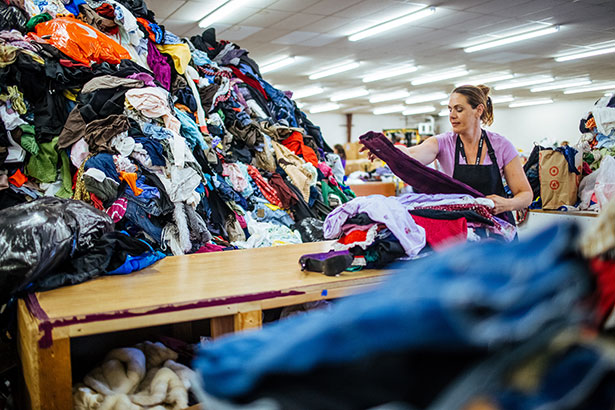 |
| Dana Weaver sorts through a mountain of donated clothing at St. Vincent de Paul of Lane County. Photo by Todd Cooper. |
The Teacher
While working as a math and computer science teacher in a Santa Monica, California high school, UO education studies professor Joanna Goode noticed a troubling trend: Although the school was ethnically diverse, that diversity did not translate to her computer science class.
“I realized this was getting at an issue much bigger than my school and classroom,” Goode says. “Why is computer science marked as a white and Asian male space? I returned to graduate school to figure that out.”
Since then, Goode and her colleagues have developed a curriculum called “Exploring Computer Science,” and it deals with barriers to entry that students of color and girls face when entering the world of computers.
School districts in Illinois, Utah, the Silicon Valley and Massachusetts all use the curriculum, and Chicago Mayor Rahm Emanuel has said that within three years all high schools in the Chicago Public Schools system will offer Goode’s curriculum.
Goode says that changing perceptions plays a role in making computer science courses diverse.
“There’s this whole belief system of who computer scientists are and what they do,” Goode explains. “Students would describe computer scientists as geeky and wearing lab coats, but the description over and over again was white and male.”
Teachers and counselors also feed into this belief by deciding that some students are suitable for computer science and others are not, Goode says.
Her curriculum seeks to provide an introduction to computer science, creating an entry point to the subject so that even students who didn’t have early access to computers can still participate. Computer science should be open to everyone, Goode says. It’s not only for geeks, and it never really was.
Although Goode has a national presence, she says she’s had a difficult time implementing her ideas locally. “Eugene is a hard place to make changes,” she says, “but a great lesson I’ve learned is to make collaborations with like-minded individuals.”
She’s connected with Eugene’s Early College and Career Options (ECCO) High School at Lane Community College and delved into the Eugene Digital Dojo, a partnership between LCC and the city of Eugene that encourages students to learn computer science in a social environment. The program was recently named Digital Equity Project of the Year from the National Association of Telecommunications Officers and Advisors.
“It helps to share knowledge and resources and connect to other people who care about what you do,” Goode says. “You don’t have to do it by yourself and, really, you shouldn’t.”
Check out exploringcs.org to learn more about the curriculum.
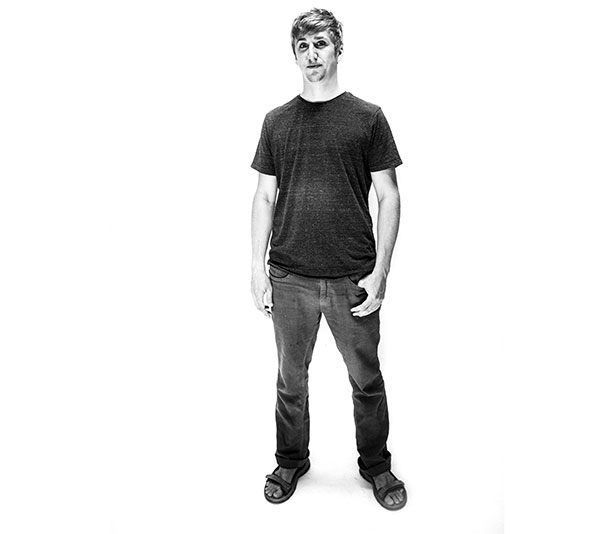 |
| Andrew Heben. Photo by Todd Cooper. |
The Builder
Andrew Heben sits inside a wood-paneled tiny house in Opportunity Village Eugene (OVE), a transitional community he helped create in west Eugene for the unhoused. The house smells of newly cut wood, crisp and fresh. The entire community is only two years old, but in that time, Heben and others have started another tiny houses project, Emerald Village Eugene, and communities around the country are paying attention to Eugene’s marvelous microhousing — the newest tiny house to grace the village is a donated 112-square-foot structure built in Berkeley, California, by high school students.
“In respect to traditional responses to affordable housing, I think this is unique mostly in that it just costs tremendously less,” Heben says. “We have a pervasive homeless population, even though we’ve had 10-year plans to end the issue that have come and gone. So I think Opportunity Village is a really good model to get people off the street.”
The village houses 30 individuals or couples who contribute $30 a month in utilities, attend a weekly meeting and help with maintenance. Low-income housing can cost $150,000 per unit, but the entire OVE project has cost under $100,000 in private donations to get started.
It’s no surprise that cities around the country have started noticing the success story happening right here in Eugene. Previously known as Opportunity Village, the nonprofit itself changed its name to SquareOne Villages in June to accommodate its multiple projects.
“I always thought that there was potential for expanding this, and that’s why a lot of people are interested, because it’s providing a model that people can take and implement in other places,” says Heben, who delivers his presentation on tiny houses around North America, using Eugene as an example.
He visited the Canadian city of Victoria, BC in May, and the very next month the city approved a project similar to Opportunity Village. Other cities that used the OVE model as inspiration include Clear Lake and Eureka in California, as well as Madison, Wisconsin.
Heben says that homeless advocates often travel up the West Coast visiting villages in Portland, Seattle and Eugene, drawing ideas and inspiration from the models they observe. He’s quick to say that OVE drew from Portland’s Dignity Village and Seattle’s Tent City 3 and 4.
Having a successful model like OVE is important, Heben says. “The next hurdle is always siting the project and getting people to accept it in their backyard. I think that’s where we might be able to offer the most as an example of something that has existed for two years.”
He adds, “People might say, ‘If you put this in my neighborhood, it’s going to result in an increase in crime,’ and that’s simply not true based on the experience we have.”
All OVE documents are available online as examples for other communities to use.
As Heben, SquareOne Villages Executive Director Dan Bryant and volunteers move forward with Emerald Village, their next tiny house project, Heben notes that part of OVE’s success came from bringing ideas to life.
“Before the [Eugene] City Council approved finding a site for us, we built a prototype of one of our microhousing units,” Heben says. “It was on a trailer that we took downtown, and it generated excitement because we showed people what we wanted to do. If you show people something they can see and touch, it’s more likely to actually happen.”
Go to squareonevillages.org for more.
The Explorer
As part of a medical team visiting Guatemala about a decade ago, Nancy Hughes was close to retirement age — she had no idea that she was about to found StoveTeam International, a Eugene nonprofit that would help more than 380,000 people.
“I was a mother and a grandmother. I didn’t know anything about nonprofits,” she says.
When she met a young woman in Guatemala who couldn’t use her hands because an open cooking fire had burned them shut at the age of 2, Hughes learned that cooking fires in developing countries cause millions of deaths each year through smoke inhalation, with millions more suffering serious burns.
“I think nobody knows about it because it affects women and children,” Hughes says.
Back in Eugene, she brought her message to the Eugene Southtowne Rotary Club, and together they wrote matching grants to purchase and distribute fuel-efficient stoves to Guatemala. They delivered around 120 stoves per year, but the process took time and it was difficult to transport the heavy cement stoves.
“We did that for a few years, but then I kept researching and found the need in Guatemala alone was six million stoves,” Hughes says. “What we were doing wasn’t adequate.”
Hughes says she almost bowed out of the program entirely until rocket stove designer Larry Winiarski showed up at her front door one day.
“He said, ‘You can’t stop doing this work. It’s really important,’” she says.
Winiarski had a pitch for Hughes: If she kept working, he would design a lightweight, energy-efficient stove and find someone to produce them.
It all came together: Guitarist Carlos Santana donated $10,000 to support the work. Hughes met with Winiarski and El Salvador’s vice minister of the environment, who had $5.5 million to invest in the project, and now StoveTeam International has helped set up stove factories in El Salvador, Guatemala, Honduras and Mexico, providing jobs to Central American countries, cutting carbon emissions and saving lives through the use of Winiarski’s Ecocina stove. Tested locally by Aprovecho Research Center, the stove reduces carbon emissions by 68 percent and particulate matter by more than 86 percent.
Hughes says she started the project with no background in business or nonprofits. “You just have to start with one foot on the trail and see how far you can go,” she says.
Visit stoveteam.org to learn more.
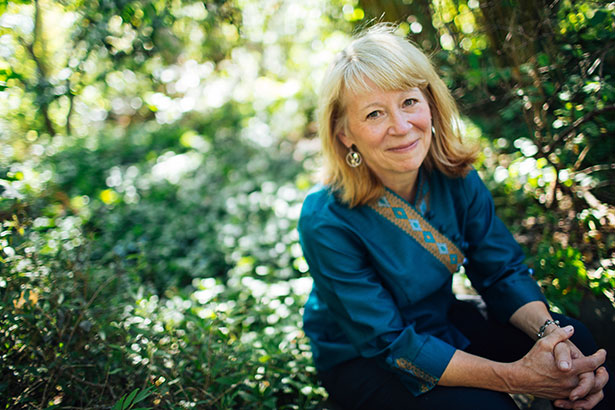 |
| Geri Richmond. Photo by Todd Cooper. |
The Experimenter
Ask UO Professor Geri Richmond for advice, and she’ll tell you this: Prepare to succeed only 10 percent of the time.
“That’s a really good philosophy for life,” she says. “If 10 percent of your ideas work, then celebrate.”
Glance at Richmond’s resume and it’s clear that she’s put her advice to good use. She runs a chemistry research lab at the UO, is soon to be president of the American Association for the Advancement of Science and serves as a U.S. Science Envoy, appointed by Secretary of State John Kerry.
She also founded an influential program called COACh that helps women scientists and engineers all over the world advance their careers. She says the program started with a small meeting of U.S. women in chemistry to discuss why women in science, technology, engineering and math (STEM) were being passed up for honors and advancement mid-career. Since then, it’s expanded to the international scale, and COACh has held workshops for women in 25 countries around the globe.
“We found that the majority of women do not ask for what they need,” Richmond says, “and so our workshops are career-building and focus on concepts like negotiation, building relationships, leadership, dealing with difficult confrontations and making yourself recognizable.”
Richmond seeks funding and recruits volunteers to travel with her to Thailand, Cameroon and Jamaica, where they work at boosting women’s confidence and giving them resources to improve their careers. These opportunities are particularly important in developing countries, Richmond says.
When pitching her workshops to other countries, Richmond says she doesn’t pose it as a solution to a problem. First, she tries to understand the culture and works with countries to determine if COACh would be helpful to them.
The program has expanded beyond Richmond’s expectations, but that ties into her 10-percent philosophy, she says.
“I’m an experimentalist,” she explains. “Not every experiment works, and that’s the way I’ve approached this. You always have to be ready to change tactics if your idea doesn’t work. This one works and was successful, and that’s great, but had it not, I would have gone on to another tactic.”
Visit coach.uoregon.edu for more.
It’s Your Turn
All these stories have a common thread: They started with an idea, and regardless of whether the people involved knew how to implement them, they charged forward and tried in spite of inexperience or self doubt.
Johnson of FertiLab Thinkubator says that more than 1,000 people came through the doors of FertiLab in Eugene last year, all brimming with ideas they wanted to hash out and discuss. That’s why FertiLab opened a new location in Springfield last month — to continue helping as many people as possible to grow their ideas.
That’s what it takes, Johnson says. It takes risk and bravery. People with ideas can’t be afraid of criticism or feedback. Ideas also need investments of both time and money. Eugeneans shouldn’t refuse to make investments that might take time to grow.
So take these examples and draw inspiration from them. If you have an idea, pursue it. If you have money to give, help someone else out. Put Eugene on the map yet again as a creative city that exports ideas.
Needless to say, there are many more ideas we’d like to put out there, so please write to us with more stories of Eugene’s blossoming ideas or, even better, come up with your own.